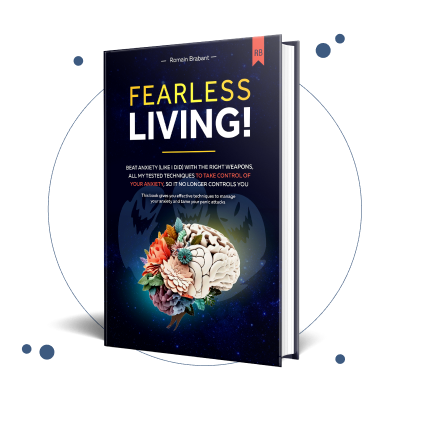
On the outside, you're the picture of success-organized, reliable, and always on top of your game. Your calendar is full, your work is praised, and you seem to handle pressure with ease. But beneath this polished exterior, is there a constant hum of worry? A relentless inner critic? An exhausting need to control every outcome?
This isn't just ambition; it might be high-functioning anxiety. It’s the paradox of appearing calm and capable while battling a storm of internal distress. Many of the world’s highest achievers operate this way, using their anxiety as fuel without realizing the toll it takes. This internal conflict between external success and internal turmoil is one of the key signs of high functioning anxiety.
In this guide, we will unmask these subtle yet significant indicators, from perfectionism and people-pleasing to the physical symptoms that seem to have no cause. You will learn to identify the patterns that keep you stuck in a cycle of overthinking and relentless doing.
More importantly, we will illuminate a clear path forward, showing you not just how to cope, but how to truly heal and build a life free from the constant grip of panic and worry. There is profound hope for a calmer, more authentic future. Your journey toward living panic-free begins with understanding exactly what's happening beneath the surface.
1. Perfectionism and Overachievement
One of the most common yet deceptive signs of high functioning anxiety is a relentless drive for perfectionism and overachievement. On the surface, this looks like ambition and success. Inside, however, it's a coping mechanism fueled by a deep-seated fear of failure and judgment. This isn't just about wanting to do well; it's an intense, often painful, compulsion to be flawless in every endeavor, from career milestones to social interactions.

This drive creates a paradoxical reality where external success coexists with internal turmoil. The constant pressure to exceed expectations becomes a heavy burden, making it impossible to celebrate achievements or feel genuine satisfaction. Instead of pride, accomplishments bring only temporary relief from anxiety, quickly replaced by the pressure of the next goal. This cycle of striving without fulfillment is a hallmark of high-functioning anxiety, trapping individuals in a state of perpetual motion and exhaustion.
What This Looks Like in Daily Life
The compulsion to overachieve manifests in various ways that often go unnoticed by others.
- At Work: An employee who consistently works late, volunteers for every difficult project, and never says "no" to a request, all while secretly terrified of being seen as incompetent.
- In Academics: A student with a perfect GPA who experiences intense dread and panic over the possibility of receiving anything less than an A.
- In Personal Life: A parent who meticulously plans every detail of their child's life, from elaborate parties to overscheduled activities, driven by a fear of being judged as an inadequate parent.
How to Reclaim Your Peace
Breaking free from the grip of anxiety-fueled perfectionism is a real and achievable goal. It involves intentionally shifting your mindset from flawless performance to sustainable effort. This isn't about lowering your standards but about making them more realistic and compassionate, opening the door to lasting peace.
- Embrace 'Good Enough': For low-stakes tasks, practice aiming for "good enough" instead of perfect. Did you send the email? Good enough. Did you tidy the kitchen? Good enough. This builds tolerance for imperfection.
- Apply the 80/20 Rule: Recognize that 80% of your results often come from 20% of your efforts. Focus your energy on that critical 20% and allow the rest to be less than perfect.
- Schedule Self-Reflection: Set aside time each week to acknowledge your accomplishments without immediately moving the goalpost. Write down what you did well and allow yourself to feel proud.
- Seek External Feedback: Ask a trusted colleague or friend for their honest perspective on your performance. This can help ground your self-perception in reality rather than anxiety-driven fears.
Key Insight: The goal isn't to stop achieving; it's to uncouple your self-worth from your achievements. Healing begins when you can rest and be proud of your efforts, not just your perfect outcomes.
For those looking to address the underlying cognitive patterns that drive perfectionism, therapeutic approaches can be incredibly effective. To understand how to reframe these thought patterns, you can explore Cognitive Behavioral Therapy for anxiety and learn structured techniques for managing these fears. Remember, you can achieve great things without sacrificing your mental peace.
2. Overthinking and Mental Rumination
A core, yet often invisible, sign of high functioning anxiety is a mind that simply won't turn off. This manifests as relentless overthinking and mental rumination, where your brain gets stuck in a loop of analyzing past events, dissecting future what-if scenarios, and micromanaging current situations. Externally, this can appear as being thorough and detail-oriented; internally, it's an exhausting mental marathon with no finish line.

This constant mental churn is anxiety's attempt to gain control over uncertainty. By playing out every possible outcome, your mind believes it can prevent mistakes and protect you from danger. However, this process often creates more anxiety than it solves. It paralyzes decision-making, drains mental energy, and keeps you trapped in a state of high alert, unable to be present in your own life. The perceived productivity of this thought process is a key deception of high-functioning anxiety.
What This Looks Like in Daily Life
This inability to quiet the mind shows up in subtle yet powerful ways that can disrupt daily peace and productivity.
- At Work: Spending hours analyzing the tone of a brief email from your supervisor, convinced there is a hidden negative meaning.
- In Social Situations: Creating multiple backup plans and conversation scripts for a simple social gathering to avoid any potential awkwardness.
- In Personal Time: Lying awake at night replaying a conversation from years ago, scrutinizing every word you said and wishing you could change it.
- In Decision-Making: Taking days or even weeks to make a simple choice, like which restaurant to go to, because you are overwhelmed by a need to make the "perfect" decision.
How to Reclaim Your Peace
Escaping the cycle of rumination is about learning to redirect your mental energy, not trying to force your thoughts to stop. The goal is to create moments of mental quiet and teach your brain that it is safe to let go of constant analysis. This is a skill you can learn, and it leads to incredible relief.
- Use the '5-Minute Worry Rule': When a worry arises, schedule a specific 5-minute window later in the day to think about it. If the thought returns, gently remind yourself, "It's not time for that yet." This helps contain the worry instead of letting it take over your day.
- Write It Down: Externalize your repetitive thoughts by writing them in a journal. Seeing your worries on paper can make them feel more manageable and less overwhelming.
- Engage in Physical Activity: Redirect intense mental energy into physical movement. A brisk walk, a workout, or even just stretching can interrupt the rumination loop and help ground you in your body.
- Practice Grounding Techniques: Use the 5-4-3-2-1 sensory method to pull yourself back to the present moment. Name five things you can see, four you can touch, three you can hear, two you can smell, and one you can taste.
Key Insight: Your mind is a tool, not your master. Healing from anxiety involves learning how to consciously direct your focus away from unproductive worry loops and toward the present moment, where peace is found.
Overthinking is a deeply ingrained habit, but it is one you can change with consistent practice. To delve deeper into the connection between these thought patterns and anxiety, you can learn more about overthinking and anxiety and discover more techniques for regaining control of your mind. Remember, a calm and quiet mind is not a distant dream; it's an achievable reality.
3. People-Pleasing and Fear of Disappointment
One of the more subtle yet draining signs of high functioning anxiety is an intense drive to please others, rooted in a profound fear of disappointment. This goes far beyond simple kindness; it's a compulsive need for approval that leads individuals to consistently sacrifice their own needs, wants, and boundaries. From the outside, it looks like selfless generosity, but internally it's an anxiety-management strategy designed to avoid conflict and rejection at all costs.

This pattern creates a significant internal conflict where your own well-being is constantly deprioritized. The fear of letting someone down becomes so powerful that saying "no" feels like a personal failure, triggering waves of guilt and anxiety. This cycle not only leads to burnout and resentment but also erodes self-esteem, as your sense of worth becomes dangerously tied to external validation. Over time, you may even lose touch with your own desires, having spent so much energy anticipating and meeting the needs of others.
What This Looks Like in Daily Life
This compulsive need to avoid disappointing others can appear in many different scenarios, often disguised as being helpful or agreeable.
- At Work: Agreeing to take on extra projects or work late every week, even when it conflicts with your personal commitments, because you're afraid to be seen as not a team player.
- In Social Situations: Staying at a party or event long after you've become uncomfortable or tired, simply to avoid the perception of being rude for leaving early.
- In Relationships: Constantly taking on friends' or family's problems as your own responsibility, offering solutions and emotional labor to the point of exhaustion.
- In Public: Automatically apologizing when someone else bumps into you on the street, taking the blame to diffuse any potential tension.
How to Reclaim Your Peace
Overcoming the anxiety behind people-pleasing is a hopeful journey of learning to honor your own needs and building the courage to set healthy boundaries. This path of self-discovery and empowerment allows you to live more authentically and build healthier, more genuine relationships.
- Practice the Pause: Instead of an automatic "yes," give yourself space. Use phrases like, "Let me check my calendar and get back to you." This pause allows you to assess your own capacity and make a conscious choice.
- Start with Small Boundaries: Begin setting boundaries in low-stakes situations. Politely decline a second helping of a dish or end a phone call when you need to go. Each small success builds confidence for bigger steps.
- Identify Your Core Values: Write down what is most important to you (e.g., family time, health, creativity). Use these values as a filter for your decisions, making it easier to say no to requests that conflict with them.
- Distinguish Kindness from Obligation: True kindness is a choice made freely, not a response driven by fear. Remind yourself that you can be a good, kind person and still have boundaries that protect your well-being.
Key Insight: Setting a boundary isn't a rejection of the other person; it's an affirmation of your own needs. True healing begins when your desire for self-respect becomes stronger than your fear of someone else's disapproval.
Understanding what situations activate this fear is a crucial step. To better understand your personal patterns, you can explore some of the common anxiety triggers that often fuel people-pleasing behaviors. Remember, it is entirely possible to build relationships based on mutual respect rather than self-sacrifice and to live a life free from the constant fear of letting others down.
4. Procrastination Paired with Last-Minute Productivity
One of the more confusing signs of high functioning anxiety is a persistent cycle of procrastination followed by intense, last-minute bursts of productivity. This isn't laziness; it's a behavior driven by overwhelming pressure. The anxiety surrounding a task, often rooted in perfectionism or a fear of not meeting expectations, leads to avoidance. The task is put off until the approaching deadline creates an even greater sense of urgency, forcing action.

This pattern creates an addictive cycle where adrenaline becomes the primary motivator. The successful completion of the task provides a powerful wave of relief, reinforcing the belief that this high-stress method works. Over time, individuals come to rely on this anxiety-fueled productivity, mistaking the frantic energy for efficiency. In reality, it's an exhausting and unsustainable way to operate, eroding mental well-being and preventing a calm, proactive approach to responsibilities.
What This Looks Like in Daily Life
This cycle of avoidance and frantic work can appear in any area of life where performance pressure exists.
- At Work: An analyst who avoids a major report for weeks, only to pull an all-nighter and produce excellent work just before the deadline, feeling both exhausted and accomplished.
- In Personal Finances: Someone who puts off filing their taxes until the final few days, creating immense stress but ultimately getting it done under pressure.
- In Social Obligations: Delaying a difficult but necessary conversation with a friend or family member until the situation becomes completely unavoidable.
- At Home: Waiting until the last possible hour to pack for an important trip, leading to a rushed and chaotic departure.
How to Reclaim Your Peace
Breaking this stress-relief cycle is possible and leads to a more sustainable way of living. It involves creating structure and addressing the underlying anxiety that triggers the avoidance. The goal is to learn how to motivate yourself with intention rather than panic.
- Break Down Large Tasks: The sheer size of a project can be paralyzing. Divide it into small, specific, and manageable steps. Completing one small task feels much less daunting and builds momentum.
- Use Time-Blocking: Schedule specific blocks of time in your calendar to work on a task. This creates a commitment and reduces the mental energy needed to decide when to start.
- Set Artificial Deadlines: Create earlier, low-stakes deadlines for yourself or with an accountability partner. This helps trigger action without the high-stakes panic of the real deadline.
- Practice Self-Compassion: Acknowledge the fear that is driving the procrastination. Instead of self-criticism, remind yourself that it’s okay to start small and produce imperfect work initially. This kindness is key to progress.
Key Insight: True productivity is calm, consistent, and sustainable. The goal is to shift from being motivated by fear of consequences to being driven by the desire for progress and peace of mind.
For many, this pattern of procrastination is deeply ingrained and difficult to change alone. Working with a professional can help unravel the cognitive distortions that fuel this cycle. If you feel stuck, you can explore how psychotherapy for anxiety can provide tailored strategies to build healthier, more peaceful habits. Healing is possible, and you can learn to achieve your goals without the constant stress.
5. Physical Symptoms Without Obvious Medical Cause
One of the more confusing signs of high functioning anxiety is the presence of persistent physical symptoms that seem to have no clear medical origin. While you might appear healthy and capable on the outside, your body may be sending distress signals. This happens because chronic anxiety keeps your nervous system in a state of high alert, and this constant stress can manifest physically in ways that are often dismissed or misdiagnosed.
The mind and body are intrinsically linked. When you're internally wrestling with constant worry and pressure, your body bears the burden. This can lead to a frustrating cycle of doctor visits, medical tests, and inconclusive results, all while the underlying cause, anxiety, remains unaddressed. These physical manifestations are not imagined; they are the real, tangible result of your body’s prolonged response to stress.
What This Looks Like in Daily Life
These physical symptoms can be persistent and disruptive, often becoming more pronounced during periods of increased stress.
- Digestive Issues: Experiencing chronic stomachaches, bloating, or irritable bowel syndrome (IBS) flare-ups, especially during a stressful project at work.
- Tension and Pain: Suffering from frequent tension headaches before important presentations or developing a constantly stiff neck and sore shoulders from subconscious muscle clenching.
- Unexplained Fatigue: Feeling completely drained and exhausted despite getting what should be enough hours of sleep, making it hard to get through the day.
- Sleep Disturbances: Having difficulty falling asleep, staying asleep, or waking up feeling unrested, which can be linked to a racing mind. For those experiencing physical discomforts like a stiff neck, which can hinder restful sleep, considering adjustments to your sleep environment, such as choosing the right pillow for better sleep, might offer some relief.
How to Reclaim Your Peace
Tuning into your body’s signals is the first step toward managing these physical symptoms and finding lasting relief. It’s about treating the root cause—the anxiety—to allow your body to finally relax and heal.
- Keep a Symptom Diary: Track your physical symptoms alongside your daily stressors and emotional state. This can help you and your doctor identify clear patterns linking anxiety to your physical discomfort, validating your experience.
- Practice Mind-Body Techniques: Incorporate practices like progressive muscle relaxation, yoga, or deep breathing exercises into your routine. These techniques directly counteract the body's stress response and teach your nervous system to feel safe again.
- Prioritize Foundational Health: Ensure you are getting adequate sleep, balanced nutrition, and regular physical activity. These are non-negotiable pillars for regulating your nervous system and building resilience.
- Consult with Informed Professionals: Seek out healthcare providers who understand the connection between mental and physical health. A doctor aware of psychosomatic symptoms can provide more holistic and effective care.
Key Insight: Your physical symptoms are not a sign of weakness; they are a valid communication from your body that it’s time to address the underlying anxiety. Healing is possible when you start listening to and caring for your whole self, not just the productive, high-functioning part.
Understanding the physiological mechanisms behind these symptoms can be empowering. These physical sensations are often tied to your body’s natural alarm system. You can learn more about the fight-or-flight response to better understand why your body reacts this way and find ways to restore a sense of calm and safety.
6. Excessive Planning and Need for Control
For someone with high-functioning anxiety, the world often feels unpredictable and chaotic. This is why another one of the core signs of high functioning anxiety is an intense need for control, which manifests as excessive and meticulous planning. This isn't just about being organized; it's a desperate attempt to manage internal anxiety by controlling the external environment. Planning becomes a primary coping mechanism, creating a sense of safety in a world that feels inherently uncertain.
The illusion of control provides temporary relief, but it's a fragile peace. When a meticulously crafted plan is disrupted, even in a minor way, it can trigger significant distress and a spike in anxiety. This reaction is often disproportionate to the actual event, revealing that the plan was never just a schedule; it was a psychological shield. Living this way is exhausting, as it requires constant mental effort to anticipate every variable and prepare for every contingency, leaving little room for spontaneity or genuine relaxation.
What This Looks Like in Daily Life
This compulsive need to control and plan can permeate every area of life, often disguised as thoroughness or responsibility.
- In Social Situations: Creating multiple backup plans for a simple dinner date, including researching menus, traffic patterns, and alternative restaurants in case the first choice is too crowded.
- During Travel: Planning every minute of a vacation itinerary months in advance and feeling intense stress if the group deviates from the schedule.
- At Work: Micromanaging team projects to ensure every detail is executed perfectly, not to empower the team but to soothe a personal fear of unforeseen errors.
- In Daily Routines: Feeling deeply unsettled and anxious when a meeting starts five minutes late or a personal appointment is unexpectedly rescheduled.
How to Reclaim Your Peace
Letting go of the need for control is a journey of learning to trust yourself and your ability to handle uncertainty. It involves intentionally introducing flexibility and embracing the unpredictable nature of life. This process can feel scary, but it is the path to true freedom and peace.
- Practice with Low-Stakes Uncertainty: Start small. Go to the grocery store without a detailed list or drive a different route home from work. This helps build your tolerance for minor deviations from routine.
- Build Flexibility into Your Plans: When you create a schedule, intentionally add blocks of "unplanned" time. This gives you a structured way to practice spontaneity.
- Identify What You Can and Cannot Control: Use a simple exercise: draw a circle and write everything you can control inside it (your reactions, your effort) and everything you can't outside it (traffic, others' opinions). Focus your energy on what's inside the circle.
- Experiment with Spontaneity: Challenge yourself to do one unplanned activity per week, like visiting a new coffee shop you pass or watching a movie you know nothing about.
Key Insight: True control isn't about managing every external detail; it's about building the internal confidence to handle whatever comes your way. Healing begins when you can find peace in the present moment, even when the future is unknown.
Comparison of 6 Key Signs of High Functioning Anxiety
| Item | Implementation Complexity 🔄 | Resource Requirements ⚡ | Expected Outcomes 📊 | Ideal Use Cases 💡 | Key Advantages ⭐ |
|---|---|---|---|---|---|
| Perfectionism and Overachievement | High – requires addressing deep mindset and habits | Moderate – time for self-reflection and possible therapy | High achievement but risk of burnout and dissatisfaction | High-stakes professions; leadership roles demanding excellence | Strong attention to detail, high reliability |
| Overthinking and Mental Rumination | Moderate – involves mindfulness and thought management | Low to Moderate – meditation and journaling tools | Improved problem-solving but risk of mental fatigue | Situations requiring analysis; avoiding impulsivity | Enhanced critical thinking and empathy |
| People-Pleasing and Fear of Disappointment | Moderate – needs boundary-setting practice and mindset change | Low – primarily behavioral adjustments and therapy | Better relationships when balanced, but risk of resentment | Social and work environments requiring cooperation | Strong interpersonal skills, emotional intelligence |
| Procrastination Paired with Last-Minute Productivity | Moderate – requires time management and habit breaking | Low to Moderate – planning tools and accountability partners | Occasionally high-quality work with stress cycles | Tasks with flexible deadlines; creative or crisis-driven work | Efficient work under pressure, crisis management |
| Physical Symptoms Without Obvious Medical Cause | Moderate to High – requires health tracking and stress management | Moderate – healthcare visits, stress-reduction practices | Early stress detection but potential medical frustration | Individuals with unexplained physical symptoms | Heightened health awareness, motivator for care |
| Excessive Planning and Need for Control | High – involves flexibility training and acceptance strategies | Low to Moderate – planning tools plus mindfulness practice | Organized outcomes but stress from unpredictability | Project management; environments requiring detailed prep | Excellent organization, problem anticipation |
From Surviving to Thriving: Your Path to a Panic-Free Life
Recognizing yourself in the patterns described throughout this article, from relentless perfectionism to the constant hum of overthinking, is not a reason for despair. Instead, view it as the first, most crucial step toward liberation. Identifying these signs of high functioning anxiety is like finding a map that, for the first time, shows you exactly where you are and, more importantly, how to get where you want to go: a place of genuine peace and internal calm.
The very traits that define high-functioning anxiety, your incredible drive, meticulous attention to detail, and deep sense of responsibility, are the same strengths that you can now harness for your healing. For years, this energy has been directed outward, fueling achievements and maintaining a flawless facade. Now, it's time to redirect that power inward, transforming it from a source of stress into a tool for self-compassion and sustainable well-being. This journey isn't about eliminating ambition; it's about untangling it from the fear that drives it.
Actionable Steps Toward Inner Peace
The path forward involves moving from unconscious reaction to conscious action. It’s about making small, intentional shifts that, over time, dismantle the architecture of anxiety.
- Embrace 'Good Enough': Challenge the all-or-nothing thinking tied to perfectionism. Start with one small task this week and consciously decide it is "good enough," even if it’s not flawless.
- Practice Mindful Pausing: When you feel the familiar spiral of rumination or the urge to over-plan, pause. Take three deep breaths. This simple act creates a space between the anxious thought and your reaction, giving you back a measure of control.
- Set One Small Boundary: People-pleasing is exhausting. Identify one small area where you can say "no" or set a limit this week. It might be declining a request or simply stating you need time for yourself.
These actions are not just coping mechanisms; they are acts of reclaiming your life from the grip of anxiety. The goal is to build a life that doesn't just look successful on the outside but feels peaceful on the inside.
If you recognize these signs in yourself, remember that seeking support is a sign of strength. Therapy can provide tools and strategies to help you manage anxiety and move towards a more balanced life. For those considering professional help, you can explore online therapy options to find a path that works for you. You do not have to navigate this alone. The profound relief of living without the constant weight of panic is not a distant dream; it is an attainable reality. Your journey from surviving to thriving begins with the very next choice you make.
Ready to turn recognition into a concrete action plan? The Anxiety Checklist is a 93-point interactive system designed by a 15-year anxiety survivor to help you pinpoint your unique anxiety triggers and build a personalized toolkit for lasting relief. Stop guessing what might work and start building a systematic, compassionate path toward a panic-free life today.

